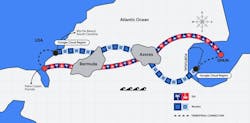Google has introduced Sol, its new transatlantic subsea cable system, connecting the U.S., Bermuda, the Azores, and Spain, with a focus on meeting growing demands for AI and cloud services.
As a complement to its Nuvem subsea cable, Sol completes its investment in transatlantic resiliency, with the two systems interconnecting terrestrially in the U.S. and in Iberia, as well as in Bermuda and the Azores.
Google’s Sol cable will be manufactured in the U.S. and, once operational, will bolster capacity and reliability for its growing network of 42 Google Cloud regions worldwide.
In the U.S., Palm Coast, Florida, will be the anchor for the Sol cable. Google will work with DC BLOX to land the cable and establish a new connectivity hub in the Sunshine State. It will also develop a terrestrial route linking Palm Coast to our South Carolina cloud region.
Upon completion, Sol will be the only in-service fiber cable between Florida and Europe.
In Spain, Google announced that it would partner with Telxius to provide the necessary infrastructure to land the Sol cable in Santander, thereby further integrating the Google Cloud region in Madrid into its global network.
“Sol will add capacity, increase reliability, and decrease latency for Google users and Google Cloud customers around the world,” wrote Brian Quigley, VP, Global Network Infrastructure, Google Cloud, in a blog post. “Alongside cable systems like Nuvem, Firmina, Equiano, and Grace Hopper, Sol further establishes key locations across the Atlantic as connectivity hubs, strengthening local economies and bringing AI’s benefits to people and businesses around the world.”
For more information on high-speed transmission systems and suppliers, visit the Lightwave Buyer’s Guide.
To stay abreast of fiber network deployments, subscribe to Lightwave’s Service Providers and Datacom/Data Center newsletters.
About the Author
Sean Buckley
Sean is responsible for establishing and executing the editorial strategy of Lightwave across its website, email newsletters, events, and other information products.

